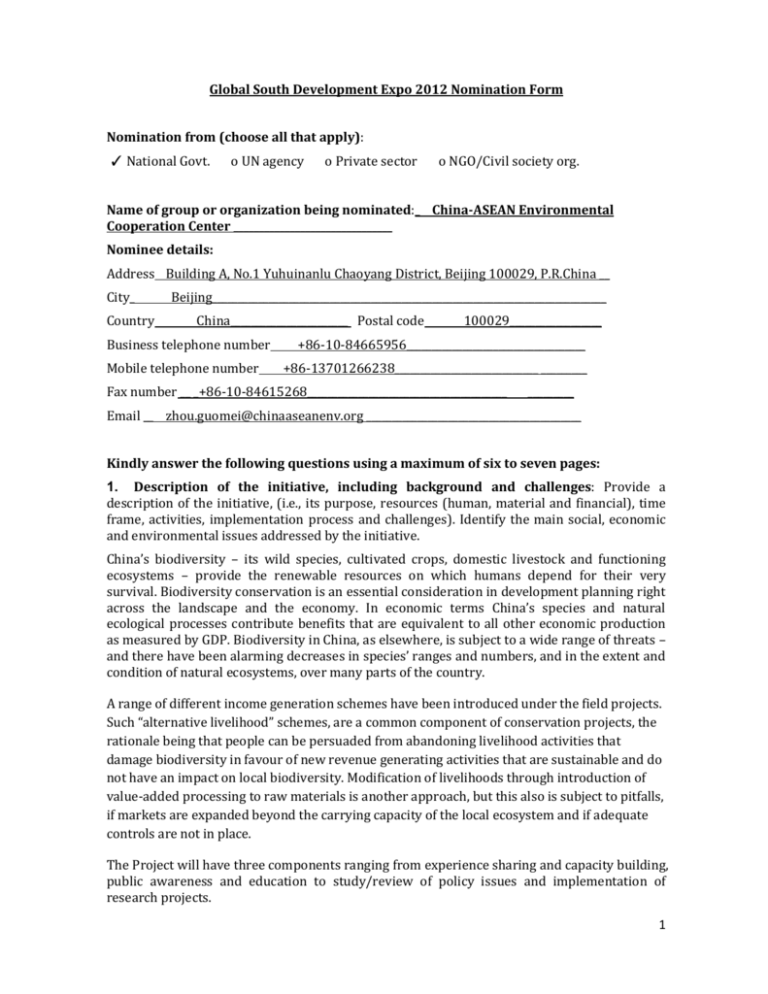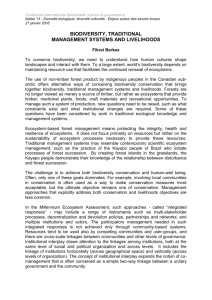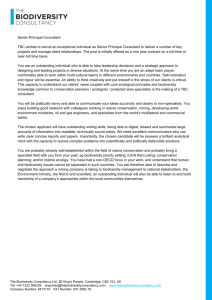2013227317380.20132221241430.2012_China_Energy Climate
advertisement

Global South Development Expo 2012 Nomination Form Nomination from (choose all that apply): ✓ National Govt. o UN agency o Private sector o NGO/Civil society org. Name of group or organization being nominated:_ China-ASEAN Environmental Cooperation Center _______________________________ Nominee details: Address Building A, No.1 Yuhuinanlu Chaoyang District, Beijing 100029, P.R.China __ City_ Country Beijing_____________________________________________________________________________ China_______________________ Postal code Business telephone number Mobile telephone number 100029__________________ +86-10-84665956___________________________________ +86-13701266238____________________________ _________ Fax number __ _+86-10-84615268_______________________________________ _________ Email __ zhou.guomei@chinaaseanenv.org __________________________________________ Kindly answer the following questions using a maximum of six to seven pages: 1. Description of the initiative, including background and challenges: Provide a description of the initiative, (i.e., its purpose, resources (human, material and financial), time frame, activities, implementation process and challenges). Identify the main social, economic and environmental issues addressed by the initiative. China’s biodiversity – its wild species, cultivated crops, domestic livestock and functioning ecosystems – provide the renewable resources on which humans depend for their very survival. Biodiversity conservation is an essential consideration in development planning right across the landscape and the economy. In economic terms China’s species and natural ecological processes contribute benefits that are equivalent to all other economic production as measured by GDP. Biodiversity in China, as elsewhere, is subject to a wide range of threats – and there have been alarming decreases in species’ ranges and numbers, and in the extent and condition of natural ecosystems, over many parts of the country. A range of different income generation schemes have been introduced under the field projects. Such “alternative livelihood” schemes, are a common component of conservation projects, the rationale being that people can be persuaded from abandoning livelihood activities that damage biodiversity in favour of new revenue generating activities that are sustainable and do not have an impact on local biodiversity. Modification of livelihoods through introduction of value-added processing to raw materials is another approach, but this also is subject to pitfalls, if markets are expanded beyond the carrying capacity of the local ecosystem and if adequate controls are not in place. The Project will have three components ranging from experience sharing and capacity building, public awareness and education to study/review of policy issues and implementation of research projects. 1 At the 11th China-ASEAN Summit in 2007, the Chinese Premier WEN Jiabao introduced a set of cooperation proposals, including the formulation of a China-ASEAN Strategy on Environmental Protection Cooperation and the establishment of the China-ASEAN Environmental Protection Center (CAEC), with the aim to build a resource-conserving and environment-friendly East Asia. With the approval of the Chinese Government, CAEC was established in March 2010. Aiming at promoting regional cooperation on environment between ASEAN Member States and China, CAEC operates independently under the guidance and with the support of the Ministry of Environmental Protection (MEP) of China. In October 2009, ASEAN and China jointly developed and adopted the “China-ASEAN Strategy on Environmental Protection Cooperation 2009-2015", which provides the foundation for China and ASEAN to promote concrete cooperation on environment. In order to promote the implementation of the Strategy and the ASEAN and China Leaders’ initiatives, the two sides then jointly formulated the "ASEAN-China Environmental Cooperation Action Plan 2011-2013", based on the principle of supporting ASEAN’s leading role in the cooperation, out of common interest and needs. As the first 3-year initiatives, the action plan lays the foundation for long-term continuous cooperation on environment between two sides. 2. Main partners: Describe the origin of the partnership and for each partner country or organization, indicate the partners’ roles and responsibilities in the planning, design, implementation and funding of the initiative. Also describe the ways in which the partnership has contributed to the success of the project or programme. The Project will cover the ten (10) ASEAN Member States – Brunei Darussalam, Cambodia, Indonesia, Lao PDR, Malaysia, Myanmar/Burma, Philippines, Singapore, Thailand and Viet Nam, as well as China. 3. Achievements and impact: Describe the estimated number and types of beneficiaries (e.g., women, children, youth, poor, victims of conflicts and/or natural disasters) and the impact of the initiative on beneficiaries’ living conditions (e.g., social, economic, environment, health, education, employment, security of tenure, crime reduction, community involvement in decisions/governance). Describe the impact of the initiative on the building of leadership capacity at the local, national, regional and/or international levels. Describe the solutions that have resulted from the activities of the project, focusing in particular on the impact of the initiative on the achievement of the MDGs. Provide quantitative and qualitative assessments. In terms of regional cooperation in biodiversity conservation, China, Myanmar, Cambodia, Vietnam, Laos and Thailand have carried out Biodiversity Corridor Project. The project is mainly to restore and maintain contact between existing national parks and wildlife sanctuaries through establishing a biodiversity conservation corridor in pilot area. CAEC is actively promoting the cooperation of the project and mechanisms. Xishuangbanna, Shangri-la deqin area, Yunnan Province and the Jingx, Guangxi Province are the key areas of project implementation. In the area of “alternative livelihood” schemes, In Liziba the CI FP supported the establishment of an economic cooperative focusing on organic tea planting and marketing. GTZ has promoted Chinese Bayberry (Myrica rubra) and mushroom cultivation in Huangbaiyuan Village, Leifeng County, Hubei. The TNC FP promoted alternative livelihoods to reduce dependence on natural resources, including bee-keeping, medicinal plant cultivation, chicken farming and garbage 2 management. They also organized training on walnut grafting techniques involving 40 villagers in Liguang Village, aimed at improving the yield and quality of wild walnuts. GTZ identified a market for cultivated wild raspberry and some people are now growing this fruit. The Xinyang FP helped 3,800 farm households establish cooperatives for tea, flowers and TCM production leading to “increased income and promotion of the farmers’ enthusiasm to participate in nature conservation”. High quality green tea was sold at premium prices, and flowers and medicinal herbs were cultivated in greater quantities and greater variety. So through the project, we would like to: (i) Experience Sharing and Capacity Building, a component aiming to develop and enhance the human and institutional capacity of the governments of AMS and China in conserving and sustainably managing their biodiversity, and in meeting their commitments as parties to various MEAs and other cooperation programs between AMS and China; (ii) Enhancement of Public Awareness, a component focusing on information dissemination and mainstreaming of knowledge in the public awareness campaigns; and (iii) promoting effective ways to poverty reduction. The expected outputs based on the different components/activities include: Manual on good practices on biodiversity and ecological conservation developed and published; Proceedings of seminar is prepared; and Collaboration and personnel exchange between and among AMS and China established. 4. Sustainability: Indicate the ways in which the initiative has achieved lasting change, including the mechanisms used to ensure sustainability (e.g., new legislation, capacity-building, empowerment). Considering sustainability, we must emphasize the importance of firm law enforcement as a back-up to the community management of renewable biodiversity resources, both of medicinal plants in Yunnan, Sichuan and Inner Mongolia – so it is a vital consideration in alternative livelihoods that rely on exploitation of wild animals and plants. Field projects provided assistance in getting local regulations approved so that people had official support in excluding people from outside the area and in self-policing their own community. Local peerenforcement is powerful as soon as the people understand the reason for the restrictions and see that they really will get some benefits and soon. 5. Innovation: Describe the main innovative aspects of the initiative, including what is innovative about the Southern solutions that it is providing/has provided. Also indicate how these solutions may be applicable to other communities’ efforts to reduce poverty or meet any other Millennium Development Goals (MDGs). We can find many ways to implement “alternative livelihood” schemes. Where collection or cultivation of TCM plants appeared to be inherently unsustainable, the project persuades people to stop collection by providing incentives and ideas for alternative sources of income. A demonstration was established in Nenghuo village on the edge of the Dafengding Nature Reserve in Meigu county, southern Sichuan, where the the project has been encouraging alternative livelihood activities such as beekeeping, and cultivation of wild vegetables and endangered species of plants important in TCM. Similar work has been done in Shaanxi through a community development fund supporting alternative livelihoods ranging from Polyporus umbellatus (a fungus used in TCM cultivation) to tree planting, home-stay and 3 catering business, bee-keeping and “improved” piggeries. So in other counties, they may find their particular ways to implement “alternative livelihood”. 6. Replicability and scaling up: Indicate whether this initiative is replicable and/or adaptable and whether the solutions from the project can be scaled up. If scaling up is possible, describe how it can be achieved. Such mechanism can be scaled up in other regions with similar configurations through policy dialogues and cooperation. 7. Areas of contribution: Explain the ways in which the initiative has made a significant contribution to any of the following areas or sectors, where applicable: a. Job creation: How has the initiative had an impact on unemployment, etc. b. Income-generation: How has the initiative benefited disadvantaged groups (e.g., women’s’ groups, indigenous peoples, rural communities, etc.)? c. Infrastructure development: What contribution has the initiative made to affordable alternative energy sources, creation of new information systems, provision of other infrastructure? d. Education: How has the initiative resulted in increased enrolment in rural schools, including improvements in quality of education, integration of science and technology with emphasis on girls, and improved physical infrastructure? e. Social inclusion: How are the solutions geared towards uplifting disadvantaged groups, women, youth and poor communities? How has the initiative had an impact on small and medium-sized enterprises and community group projects? f. Outreach: How have the solutions had an impact on changing peoples’ attitudes, lifestyles and understanding (e.g., regarding HIV/AIDS, agricultural innovations, changes of education curriculum, human rights, etc.)? g. Networks: How has the initiative provided solutions that link various individual groups, organizations and government through networks (e.g., scientists and governments to address a particular issue; NGOs; women groups)? h. Environment: How have solutions contributed to conservation, management of natural resources (e.g., sustainable forest management), pollution mitigation, minimization or combating of poaching of wildlife, etc.? i. Global health: How environmental, societal and life-style factors create an impact on health? What are the challenges the community and individuals are faced with to come up with practical and sustainable solutions? The designed project components/activities will: a) enable the governments of AMS and China to coordinate and implement the cooperation strategy and its activities; and b) assist the governments of AMS and China in building their awareness and capacities on biodiversity and ecological conservation through experience sharing and capacity building, public awareness and education, policy studies and research. This initiative will contribute greatly to national capacity improvements in environment related sectors. It will build up national capacity, and 4 enhance public awareness by information dissemination, public awareness campaigns, and mainstreaming knowledge in the educational systems. 8. Awareness of the initiative: Indicate how information on the initiative and its results has been disseminated (media, publications, lectures, web sites, etc.). Where possible, send copies of the actual articles as an annex. The Project is targeting at poverty reduction and biodiversity protection, as well as experience sharing and capacity building. It will adopt all potential approaches to disseminate experience, knowledge, and best practice. Such approaches include inter alia media, publications, workshops/seminars, lectures, and web sites. 9. Other information: Please include any other information that is relevant regarding the potential of the initiative to advance human development in the context of South-South cooperation. The project aims to improve national capacity of AMS countries and China. It will definitely advance human development in the context of South-South cooperation. Please send the completed form to: Bob Kakuyo: Bob.Kakuyo@unep.org Rui Zhang: Rui.Zhang@unep.org Thank you 5







